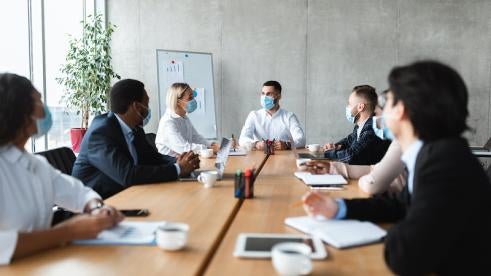Recently OSHA updated its guidance on Mitigating and Preventing the Spread of COVID-19 in the Workplace for employers who are not covered by the “COVID-19 Emergency Temporary Standard for Healthcare.” As we explained before, the ETS applied to healthcare services and healthcare support services. OSHA’s update reflects the CDC’s newest mask and testing recommendations for fully vaccinated people and provides links to guidance with the most up-to-date content.
OSHA makes clear that employers must remain vigilant and take appropriate steps to prevent exposure and infection regardless of vaccination status. This is not surprising in light of the preliminary evidence suggesting that vaccinated people who become infected with the Delta variant can be infectious and can spread the virus to others.
The CDC’s Mask Guidance
This evidence has led the CDC to update recommendations for fully vaccinated people to reduce their risk of becoming infected with the Delta variant and potentially spreading it to others. The CDC suggests that fully vaccinated people can stay safe by:
-
Wearing a mask in public indoor settings in areas of substantial or high transmission;
-
Choosing to wear a mask regardless of level of transmission, particularly if individuals are at risk or have someone in their household who is at increased risk of severe disease or not fully vaccinated; and
-
Getting tested three to five days following a known exposure to someone with suspected or confirmed COVID-19 and wearing a mask in public indoor settings for 14 days after exposure or until a negative test result.
OSHA’s Latest Guidance
In its newest guidance, OSHA adopts recommendations consistent with the CDC. While the guidance is not a standard or regulation and does not create new legal obligations, it does telegraph what OSHA thinks you should do to keep your workplace safe and healthy and previews what kinds of things OSHA might ask in a workplace investigation involving a COVID-19 death or outbreak. In short, following OSHA’s recommendations may mitigate or minimize your liability.
So, what does OSHA recommend now?
-
Facilitate employees getting vaccinated. That may mean granting paid time off for employees to get vaccinated and to recover from any side effects. OSHA further suggests that employers consider adopting policies that require workers to get vaccinated or to undergo regular COVID-19 testing – in addition to mask-wearing and physical distancing – if they remain unvaccinated.
-
Instruct any workers who are infected, unvaccinated workers who have had close contact with someone who tested positive, and all workers with have COVID-19 symptoms to stay home from work to prevent or reduce the risk of transmission. That means you should evaluate your absence policies to ensure they are not punitive and eliminate or revise policies that encourage workers to come to work sick.
-
Implement physical distancing in all communal work areas for unvaccinated and otherwise at-risk workers. In some circumstances depending on your specific workplace setup and quality of ventilation, that may mean limiting the number of unvaccinated or otherwise at-risk workers in one place at any given time, implementing flexible worksites, allowing for telework, or implementing flexible work hours and meeting options. This will look different at different worksites but think about how it might work at yours.
-
Provide workers with face coverings. Especially, if you work in an area of substantial or high transmission, the CDC recommends that even fully vaccinated people wear masks in public indoor settings so OSHA will want to see that your workers are masked.
-
Educate and train workers on your COVID-19 policies and procedures using accessible formats. Communicate your policies clearly, frequently and via multiple methods. Also, your policy should include basic facts about COVID-19 (including how it is spread and the importance of physical distancing, ventilation, vaccination, use of face coverings, and hand hygiene) and workplace policies and procedures that you have implemented to protect workers from COVID-19 hazards. Finally, your policy should inform workers who to contact with questions or concerns about workplace safety and health, and their right to raise workplace safety and health concerns free from retaliation.
-
Suggest or require that unvaccinated customers, visitors, or guests wear face coverings in public, indoor settings in areas of substantial or high transmission. That means posting a notice or otherwise suggesting or requiring that people wear face coverings, even if no longer required in your jurisdiction.
-
Maintain ventilation systems.
-
Perform routine cleaning and disinfection.
-
Record and report COVID-19 infections and deaths. Under mandatory OSHA rules, employers are required to record work-related cases of COVID-19 illness if the following conditions are met: (1) the case is a confirmed case of COVID-19; (2) the case is work-related; and (3) the case involves one or more relevant recording criteria, e.g., medical treatment or days away from work. You must also follow mandatory OSHA rules when reporting COVID-19 fatalities and hospitalizations. When an employee reports a positive test, think about asking where the employee thinks he or she was exposed. If the employee reports a sick relative or a recent tailgate, write that down and know that you have evidence that it is not work-related.
What can you expect if OSHA comes knocking after a COVID-19 death or outbreak?
If you do get notice of an OSHA inspection following the death of an employee due to COVID-19 (an OSHA investigation is possible whether or not its alleged the employee contracted the virus at work) or an outbreak at your facility or workplace, you can be sure the investigation will begin with a document request. Below are some examples of the specific information/documentation OSHA might request:
Regarding General Facility
-
Copies of any written plans, SOPs, or procedures to address worker exposure
-
Documentation of training provided to employees regarding COVID-19 hazards
-
Documentation of cleaning operations and schedules
-
Detailed description, photos, and/or videos of controls implemented to address exposure to COVID-19, e.g., modifications to workstations
-
Documentation showing what PPE (e.g., masks, gloves) is available, how its distributed, and how employees are trained on proper use
Regarding Employee Death
-
Incident reports
-
Job title and area of facility the decedent worked in
-
Work schedule for three weeks prior to death
-
Contact information for supervisor and coworkers who worked in the same area or performed the same work
-
Information regarding whether the facility had any employees who were suspected or confirmed to have COVID-19 in the prior month
-
Information regarding whether the decedent worked with or around any employees who were suspected or confirmed to have COVID-19, and if so, when
-
Information regarding whether the facility had any visitors, clients or customers who were suspected or confirmed to have COVID-19 in the prior month
-
Documentation that you performed a risk assessment regarding COVID-19 exposure of employees and whether it was shared with employees
-
Guidance you used or followed to protect employees
-
Documentation showing whether the decedent was provided with PPE and whether he/she used it while performing duties
-
Training materials and records for the decedent regarding PPE use and maintenance
-
Documentation of the sanitization schedule and description for the facility as it relates to COVID-19 (and Safety Data Sheets for any cleaning chemicals used)
-
Documentation of whether there have been any changes to workplace procedures, controls, PPE selection/use/maintenance or training since the incident and if so, a description of those changes
Takeaways
Keep in mind that if an employee dies because he or she contracted the virus, OSHA may open an investigation or issue a document request regardless of whether there has been an allegation the employee contracted the virus in the workplace. Thus, the lessons to be gleaned are (1) implement effective policies and written procedures to protect employees from infection, (2) train supervisors and employees on those policies, (3) enforce those policies, and (4) keep thorough records of everything your company is doing to prevent the spread of COVID-19.




 />i
/>i
